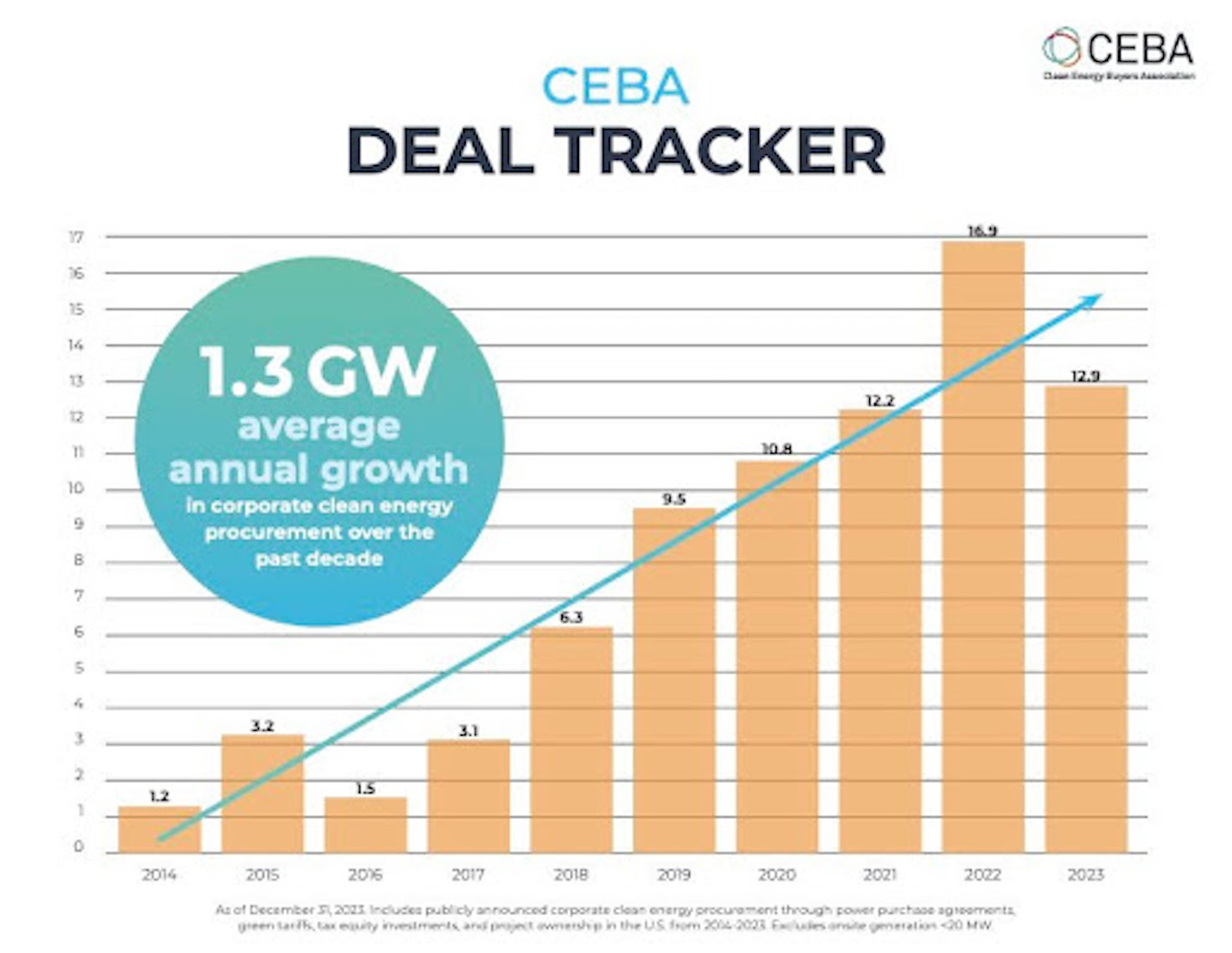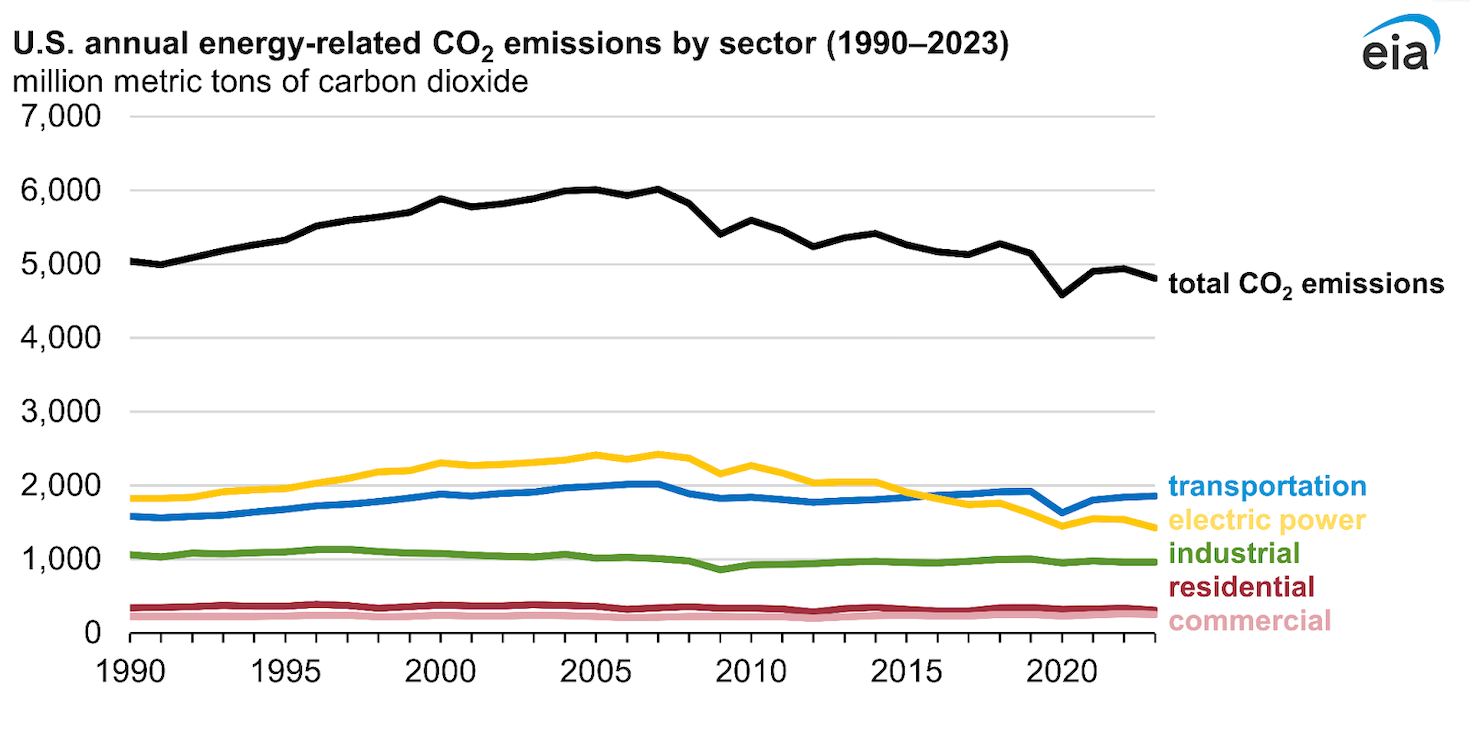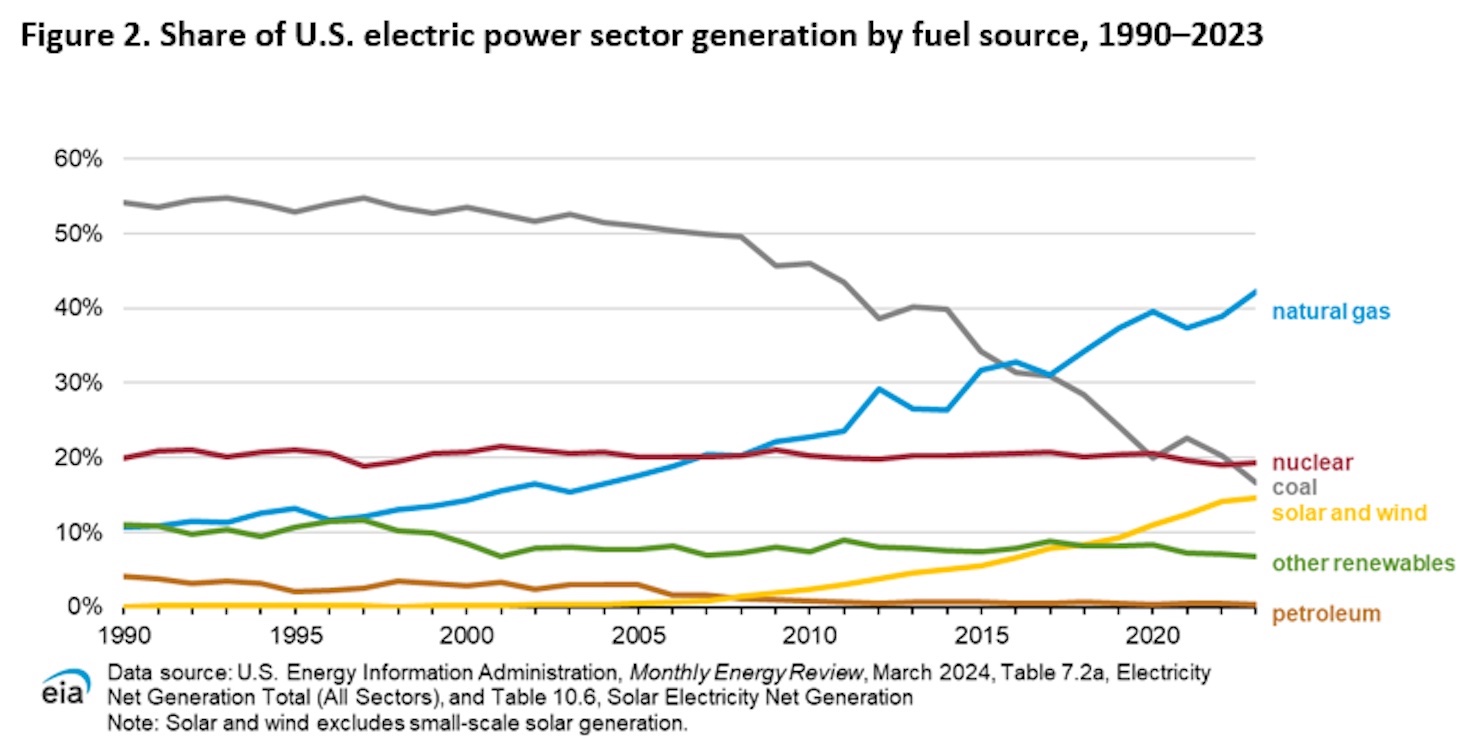Note: This column is based on a talk Weihl gave at the CEBA Summit in May.
I’ve been involved in corporate sustainability and clean energy work for almost two decades. And I was heavily involved in the creation of REBA (Renewable Energy Buyers Alliance), now renamed CEBA (the Clean Energy Buyers Association).
CEBA is a remarkable success story — of collaboration, growth and impact. Its history holds key lessons for all of us on the importance of public policy as an accelerator of private action on climate, and on how our focus must shift over time to take advantage of the biggest leverage points in the system. Those lessons lead to several calls to action I’ll provide at the end.
Before 2010, many companies had bought clean energy — but usually either through installing on-site solar, which tends to be small scale, or purchasing unbundled RECs (renewable energy certificates), which typically has weak additionality. Starting in 2010, with Google’s first big wind PPA (power purchase agreement) for about 110 megawatts (MW), Google, Facebook and a few other companies signed contracts for clean power — and learned how hard it was to replicate such PPAs. Most utilities had no standard tariff for clean energy. Each deal was a complicated one-off negotiation.
When we launched REBA in 2016, we set a goal to help corporations purchase 60 gigawatts (GW) of additional renewable energy in the U.S. by 2025. REBA and its founding members focused on “green tariffs” that would allow any large customer to buy clean energy. We were successful in many jurisdictions in part because of the power of collaboration: Dozens of companies wanted to buy clean energy and collectively had enough buying power to bring utilities and policymakers to the table.
This collective effort led to astonishing progress. The CEBA Deal Tracker makes this clear:

![]()
![]()
![]()
![]()
![]()
![]()
![]()
![]()
![]()
Since 2014, energy customers have voluntarily procured 77 GW of clean energy — already surpassing the goal of 60 GW by 2025 that we set in 2016.
Why PPAs and voluntary procurement?
Why did we focus on PPAs, green tariffs and voluntary procurement? For many of us, the biggest climate issue was our use of electricity. We wanted control of our own destiny — rather than being subject to the slow pace of decarbonization at most utilities. We also wanted real additionality, and to add new clean power on the same regional grid as our facilities. Also, recall that 15 years ago the global economy had just imploded. Project developers couldn’t find buyers or financing. At the same time, wind was getting cost-competitive. That presented an enormous opportunity for us to have real impact by making voluntary purchase commitments.
Given the state of the market then, and how early we all were in our own climate action journeys, at that moment it made sense to focus on market access to accelerate corporate purchases. The impact since has been huge.
The not-so-good news
In spite of the growth in corporate purchases of clean energy, global emissions are still rising, with emissions from fossil fuels and industry hitting a new high in 2022 after dipping slightly during the height of the COVID pandemic. (It’s likely that 2023 emissions set another record, and that 2024 will as well.) And we keep hitting new records for global temperatures. In January, for the first time, the 12-month running mean temperature anomaly exceeded 1.5 degrees Celsius. Our carbon budget is literally going up in smoke.
At the same time, few companies are on track to meet their net-zero goals, and won’t without supportive public policy. In the end, it’s all about moving faster, and at a far greater scale — not just to decarbonize company by company, but to do it across the entire economy.
Where should we focus now?
So where are the big leverage points now? Let’s look at some data.
Thanks in part to the work of CEBA and its members, the electricity sector is cutting emissions. Indeed, in the U.S., most of the emission reduction is due to changes in electricity generation:

![]()
![]()
![]()
![]()
![]()
![]()
![]()
![]()
![]()
This is a bright spot. But if our goal is to address the climate crisis at scale, it’s worth noting a couple of thorny issues that remain.
First, other sectors — such as transportation, buildings and industry — are not yet on a path to cut emissions rapidly. All businesses depend on those sectors.
Second, if we look at the electricity sector in more detail, we see rapid reduction in coal, and rapid increases in solar and wind — but also big increases in gas-fired power generation:

![]()
![]()
![]()
![]()
![]()
![]()
![]()
![]()
![]()
![]()
![]()
Emissions in this sector are dropping, but not nearly fast enough. And we’re building new long-lived assets that will emit greenhouse gasses for decades to come. Also, demand is outstripping supply — especially for renewables.
We need more companies to buy clean energy, and we need to continue to change policy to ease market access to clean energy — including firm clean power that’s available at all times.
But given the current state of the electricity grid and markets, it is vital to focus on policy reform to be able to build and connect clean energy much more quickly, and transmit it long distances to load centers. That will help us meet most or all load growth with clean energy. We also need rapid changes in policy to transition the existing gas-fired power generation fleet to clean energy. There are knotty problems there — but energy buyers can help untangle them.
Equally important, as the graphs above show, we need to broaden our focus beyond electricity. We need policy to accelerate progress on decarbonizing transportation and buildings, not to mention heavy industry and agriculture.
This is not meant to minimize the need for private sector action, and for innovation. Both are vital. Without strong policy support, however, progress on reducing emissions will continue to be too slow.
Specific calls to action
What actions can individuals, their employers and their trade associations take to help accelerate policy progress? Here are some suggestions:
- For individuals, sign the LEAD Statement. We launched it publicly at the GreenBiz 24 conference in February; since then, nearly 1,000 sustainability and energy professionals have signed, calling on companies to raise their voices for climate policy. This clear, strong statement from the community of expert practitioners at the heart of corporate work on climate is already changing the conversation in many companies.
(Note: Signers are making a personal statement, not a corporate commitment. Also, many feel comfortable putting their names on this publicly — but some do not. So you can sign publicly or confidentially, where we won’t reveal your name or affiliation.)
- For companies that care about climate: They should speak up much more often — and really lean in to advocate for climate and energy policy. Not just on Capitol Hill — but everywhere they have a significant operating presence.
- One element of the LEAD Statement calls on companies to leave trade associations that are obstructing progress on climate policy. This is key — and for some, controversial. If you can change a trade association from the inside, stay and drive change. But if you’ve been trying to change them for five or 10 years, as some members of the U.S. Chamber of Commerce have, it’s time to leave.
- Finally, for companies and trade associations: It’s time to break out of narrowly construed lanes and engage broadly on energy and climate policy. Climate is material to the future health of your business and the economy, and other sectors (transportation, buildings, industry and agriculture) all contribute substantially to most companies’ value-chain emissions.
If you’re looking for specific things your company can do in the near term to strengthen its advocacy muscles:
- We Mean Business Coalition is accepting additional signatories for its “Fossil to Clean” letter. Your company should sign if it hasn’t already.
- Engage with Ceres on an amicus brief supporting the SEC regulations.
- Speak out in support of the new EPA power plant rules.
- Finally, if your company is in any way affected by the Inflation Reduction Act, speak up publicly about its benefits and why we should protect it from rollback attempts.
It’s go time
This is an absolutely critical moment for climate. There are signs of hope — including the work so many companies and sustainability professionals do every day. And there are more danger signals telling us we need to move faster.
Now is the time for the community of sustainability professionals, and their employers, to speak up and step up to dramatically accelerate the systemic change needed to achieve a just transition. Sign the LEAD Statement and share it with colleagues, especially those in government affairs. Engage with CEBA, We Mean Business, Ceres, ASBN (American Sustainable Business Network), and other groups to raise corporate voices together and as individual companies. It’s time to go big — and scale progress rapidly across all sectors of the economy.
Bill Weihl is founder and chief strategic adviser of ClimateVoice.
[Streamline your supply chain at VERGE 24 (Oct. 29-31, San Jose), the hub for professionals driving transformative, decarbonized and profitable change.]
- SEO Powered Content & PR Distribution. Get Amplified Today.
- PlatoData.Network Vertical Generative Ai. Empower Yourself. Access Here.
- PlatoAiStream. Web3 Intelligence. Knowledge Amplified. Access Here.
- PlatoESG. Carbon, CleanTech, Energy, Environment, Solar, Waste Management. Access Here.
- PlatoHealth. Biotech and Clinical Trials Intelligence. Access Here.
- Source: https://www.greenbiz.com/article/lesson-collective-buying-power-how-use-your-voice-drive-climate-policy
